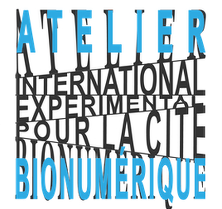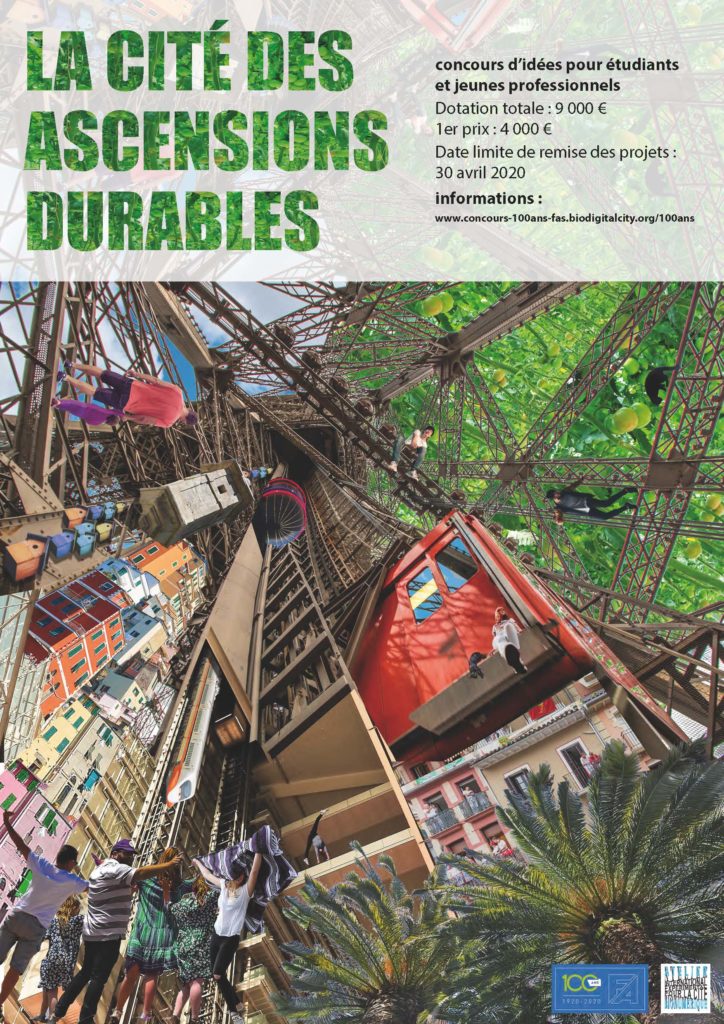Architecture competition reserved for students and young professionals () "The City of Sustainable Ascents" 9,000 euros in prizes
having graduated less than 5 years ago
Inventing a sustainable and smart city for a better living together On the occasion of its 100th anniversary, the Elevators Federation wishes to celebrate the avant-garde ideas that underpinned its founding. It wants to contribute to the emergence of new urban and architectural solutions for the medium and long term. It aims to contribute to improving the living environments of tomorrow by 2050. She asked the International Experimental Workshop for the Bio-Digital City, which specializes in forward-looking projects, to organize an architectural and urban planning competition for young professionals and students. The aim is to think about improving living conditions in the city and combating the negative effects of cities on the planet. During this competition, the Elevators Federation and the International Workshop wish to foster interdisciplinary cooperation (creative, scientific, specialists in new techniques, computer scientists, specialists in Humans etc.) to think more about the future. The latest generation of mechanized circulations (elevators, elevators, etc.) incorporates state-of-the-art digital techniques, such as artificial intelligence, home automation or robotics. Thanks to this technological renewal, they can facilitate urban and architectural re-organization. They propose new uses of old premises that have become difficult to use. They can help make small urban centres functional. These high-tech travel devices are capable of interface with other advanced techniques, such as those related to soft transport or urban robotics. The storage and transport of materials and energy can be envisaged in a new way by favouring short cycles. Mechanized circulations can promote "very short recycling", healthy eating, increased and more user-friendly urban densities and better management of commons. They enable new solutions to improve the quality of life in the city and the environmental quality. The interface between city centres, optimized waste recycling, peri-urban permaculture of proximity, urban agriculture or automatic lombricultures, find with these new techniques new process opportunities that it must invent in the coming decades. By re-densifying city centres emptied of their inhabitants, peri-urban organic farming can flourish by staying close to local consumers and adapting in real time to their needs. This agro-urban synergy can promote bio-diversity and the re-installation of the sweetness of living in the city. In this context of the recapture of the city centres, new perspectives are opening up for theories, practices, management, urban governance. As the number of seniors increases, many of the urban areas that had become difficult to access may once again be made available to them. Similarly, thanks to new technical know-how, people with reduced mobility have found new eases of use for buildings and urban spaces. All these inhabitants, who represent a significant part of the population, can now hope for further improvements in all forms of accessibility. The technical know-how carried by elevator and elevator specialists can potentially make life easier for all users, but it can also provide extra safety. Buildings that have lost their functionality, and therefore their value due to difficulty of use, can now be put back on the real estate market and render new services. Programs to be invented Candidates will have to make forward-looking assumptions and propose new forms of use of built-up spaces and public spaces that will use existing state-of-the-art technologies. They will also be able to open their project to technologies still in experimentation; they will deduce new ways of meeting the expectations of different categories of users. The aim for the candidates of the competition is to show how the new techniques, proposed by specialists in the translation of materials and people, allow to invent "better living together", to better develop agricultural areas peri-urban areas, better fight against energy waste, better recycling, stop consuming agricultural land, improve urban living environments and quality of life in cities, etc. Multi-disciplinary teams involving architects, engineers, urban planners, ecologists, landscapers, agronomists, philosophers, computer scientists, mathematicians, roboticists, geographers are desired. The site and program will be freely chosen by the candidates. For example, candidates may choose to work on a city centre, neighbourhood, urban complex or old building. They will also be able to present a new building or set of buildings. Projects will also include dense villages, new or old, located on a nourishing agricultural territory. The aim is to show how new modes of housing, work, leisure, not penalizing for the planet and beneficial for living it together, can be fostered by new techniques in the mechanical translation of materials and People. In order to encourage reflection on high-density, high-service and high-environmental urban solutions, candidates will be able to reflect on high-rise urban islets where vertical traffic will have an important role to play in play in the quality of use and management of urban spaces. During the competition, participants will be able to develop a group of high-rise buildings, forming a self-contained neighbourhood. The selected unit is 10,000 inhabitants. The urban complex will be sketched in 3 dimensions. It will be possible to work on a general principle of vertical traffic at the neighbourhood level. It will also be possible to choose a single high-rise building to study the strategy of service by the elevators. The urban complex can be installed either in a dense city or in the suburbs. It will also be able to be located in the countryside and be in harmony with an agricultural territory. A reflection can also be carried out by the candidates on how urban agriculture can be improved by innovations in forced mechanical transport (production, transport, culture). Participants will also be able to reflect on how vertical or horizontal translation techniques can help design multi-level townhouses that can build denser urban fabrics. Candidates will be asked to develop a reflection on how innovative techniques and materials can make compatible interlocking functions and uses that previously could not work together. It goes without saying that such a reflection will allow candidates to approach urban density from a new perspective. It would then make sense for candidates to work on how the technologies used in townhouses can be used in new built-up contexts and open the door to new mixes in dense or very dense environments, or even in high-density urban area. Finally, consideration could also be taken on other uses of the basements through elevation techniques, thus making it possible to intensify urban uses without creating a new nuisance on the ground or on the floor. Contest website: www.concours-100ans-fas.biodigitalcity.org/100ans/





